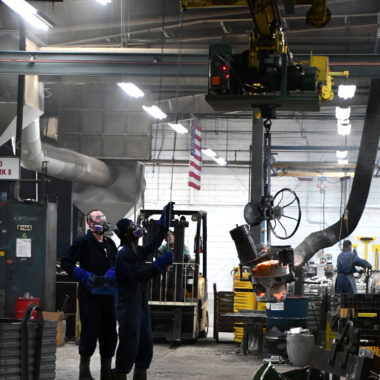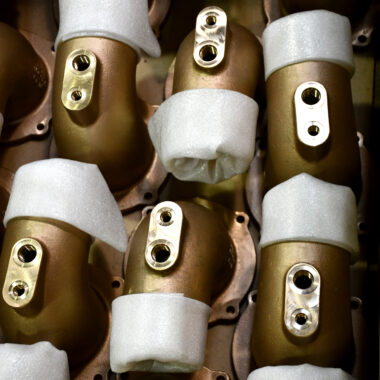Development Unleashed: Advancing Casting Aluminum Illinois
Development Unleashed: Advancing Casting Aluminum Illinois
Blog Article
Precision and Perfection: Ideal Practices for Successful Aluminum Casting
In the world of light weight aluminum spreading, accomplishing accuracy and perfection is not simply a goal but a standard that distinguishes excellence. The meticulous process of light weight aluminum spreading needs interest to detail at every stage, from material selection to last ending up touches.
Product Choice
When thinking about material selection for light weight aluminum casting procedures, longevity, and warmth resistance are vital aspects to examine. Light weight aluminum alloys use a variety of alternatives, each with special properties that can significantly influence the high quality and efficiency of the last casted product. One usual option is the 356 alloy, known for its superb fluidity and resistance to deterioration, making it appropriate for a variety of applications. For high-stress settings needing superior stamina, the 7075 alloy sticks out as a result of its high strength-to-weight ratio. Furthermore, the 6061 alloy is preferred for its excellent weldability and formability, making it a versatile alternative for complex designs.
In the selection process, it is vital to take into consideration not just the mechanical residential or commercial properties of the alloy however likewise its thermal features. Warmth resistance is necessary to guarantee that the casted part can stand up to the temperature levels it will certainly be revealed to throughout procedure without endangering its architectural honesty. By carefully evaluating the resilience and heat resistance of different aluminum alloys, manufacturers can make informed choices that cause high-quality, reliable casted items.
Mold And Mildew Layout
In the world of aluminum casting best practices, an integral aspect that dramatically affects the last product's quality and integrity is the thorough layout of the mold and mildew. Mold design plays a crucial duty in figuring out the dimensional accuracy, surface coating, and general complexity of the cast light weight aluminum part. When producing a mold for light weight aluminum spreading, a number of key variables need to be thought about to ensure optimum results.
Firstly, the mold and mildew design need to represent the material circulation qualities of molten light weight aluminum to avoid issues such as shrinking, porosity, or misruns. Proper gating and riser positioning are important components in the mold layout process to facilitate smooth metal circulation and lessen the development of air pockets.
Furthermore, the mold style should consider the cooling price of the aluminum to stop breaking or distortion throughout solidification. Sufficient airing vent and cooling channels within the mold and mildew can help control the temperature level distribution and advertise consistent solidification of the metal.
Refine Optimization
To enhance performance and quality in aluminum spreading, procedure optimization plays a critical function in streamlining operations and maximizing outcome. By fine-tuning each action of the spreading procedure, producers can determine traffic jams, lower waste, and enhance overall efficiency. One vital facet of process optimization is the integration of sophisticated modern technologies, such as computer system simulations and anticipating modeling, to analyze and improve casting specifications. These tools enable for digital screening of various circumstances, leading to optimized casting designs and minimized trial-and-error on the store floor.
Moreover, implementing lean production concepts can additionally improve process optimization in aluminum spreading. By removing non-value-added activities and focusing on continuous improvement, suppliers can attain higher efficiency degrees and much better resource application. In addition, routine monitoring and evaluation of crucial performance indications (KPIs) assist in identifying locations for enhancement and making data-driven decisions to maximize the casting procedure consistently.
High Quality Control
Process optimization in light weight aluminum casting not just improves performance and efficiency but additionally lays the foundation for rigorous quality assurance measures to promote market criteria. Quality control is extremely important in making sure that final light weight aluminum castings satisfy the required specs and efficiency requirements. Implementing a detailed quality assurance process entails various actions, starting from the preliminary layout phase with to the last assessment of the actors parts.

Furthermore, establishing clear top quality control procedures and documentation treatments is vital for tracking and checking the casting procedure. By preserving detailed documents of production criteria, testing outcomes, and assessment reports, makers can make certain uniformity and traceability in their aluminum casting procedures. Sticking to rigorous high quality control techniques not only boosts the overall integrity of aluminum spreadings yet likewise infuses confidence in consumers concerning the top quality of the end products.
Ending Up Techniques
Just how can aluminum casting be boosted through careful application of ending up techniques? Completing strategies play an important duty in boosting the high quality and aesthetics of aluminum castings. Among the key methods utilized is surface area smoothing, which entails the removal of any flaws or harsh sides to attain a flawless finish. This process not only improves the aesthetic allure of the spreading but likewise boosts its overall performance by making sure harmony and accuracy.

In addition, techniques like powder layer or painting can be related look what i found to light weight aluminum castings to supply both visual appeal and extra defense against environmental variables. By carefully choosing and using the appropriate completing methods, suppliers can guarantee that their light weight aluminum spreadings fulfill the highest requirements of top quality and efficiency.
Conclusion
To conclude, effective light check my site weight aluminum spreading requires precision and excellence in product option, mold design, process optimization, quality assurance, and completing strategies. By adhering to best practices in each of these areas, producers can make sure high-grade and regular cause their aluminum casting processes. casting aluminum illinois. It is vital to focus on every information and constantly aim for renovation to accomplish ideal results in light weight aluminum casting
The precise process of aluminum casting needs focus to information at every phase, from material selection to final finishing touches.To boost performance and top quality in light weight aluminum casting, process optimization plays a pivotal role in maximizing and simplifying procedures outcome.Process optimization in light weight aluminum spreading not only enhances performance and efficiency however also lays the structure for rigid quality control measures to promote market standards.One crucial facet of high quality control in aluminum spreading is the use of innovative screening techniques to assess the honesty and residential properties of the castings.In verdict, successful light weight aluminum casting requires accuracy and excellence in material option, mold layout, process optimization, top quality control, and completing strategies.
Report this page